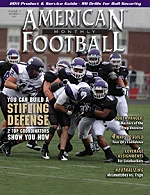AMERICAN FOOTBALL MONTHLY THE #1 RESOURCE FOR FOOTBALL COACHES
Article CategoriesAFM Magazine
|
Strength Report: Correcting Movement Dysfunction - Part II: Interpretationby: Bryan DermodyAssistant Strength and Conditioning Coach, New York Jets © More from this issue In the first installment of this series, we learned that movement dysfunction is a leading predictor of injury in athletes. We also learned what movement dysfunction is and what we are looking for in evaluating athletes in accordance with the stacked joint approach of the human body. Finally, we set up a simple evaluation to determine and quantify movement dysfunctions. In Part II of the series, we will learn how to interpret the evaluation scores, discuss implications of the scores, and determine how to assign athletes to corrective exercise groups. In Part ....The full article can only be seen by subscribers.
|
|
|||||||
| HOME |
MAGAZINE |
SUBSCRIBE | ONLINE COLUMNISTS | COACHING VIDEOS |
Copyright 2025, AmericanFootballMonthly.com
All Rights Reserved






